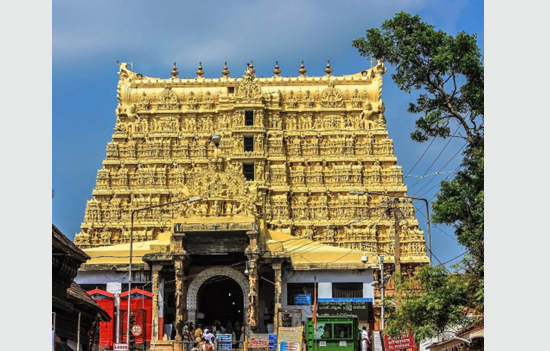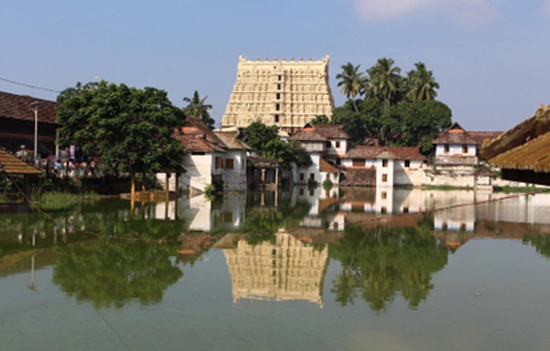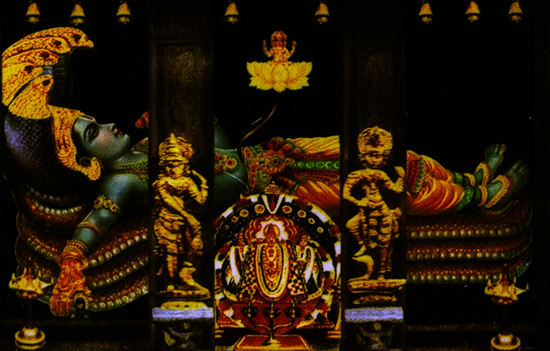- Personal and deeper experiences of visit to the Sri Padmanabhaswamy Temple in Trivandrum along with do’s and don’ts during temple visit.
Our recent visit
to the Sri Padmanabhaswamy Temple in Trivandrum was truly extraordinary, made
even more special by the VIP Swaran Darshan passes we were fortunate to obtain.
This ancient temple, dedicated to Lord Vishnu, is not just a place of worship; it's a treasure trove of history, art, and spirituality, shrouded in an aura of mystery and reverence. (It's fascinating to note that 'Padmanabha' literally means “one sprouting from the lotus,” a beautiful image that speaks to the deity's divine origins.)
The temple complex sprawls across a substantial seven acres, enclosed within fortress walls that lend an air of grandeur and security. Stepping inside, you're immediately struck by the vastness of the space and the intricate beauty of its architecture. The main temple building is a marvel, seamlessly blending Kerala and Dravidian styles. It houses the sanctum sanctorum, where the deity resides, along with other important shrines dedicated to different gods. As you wander through the complex, you'll encounter towering gopurams, the majestic flagstaff, the sacred Padmatheertham tank, and the spacious Sreebalippura (oblong corridor). This expansive layout allows devotees to move freely and experience the spiritual ambiance, creating a sense of awe and reverence.
The temple walls
and pillars are adorned with intricate carvings and sculptures, a testament to
the skill and artistry of the craftsmen who built it centuries ago. The architecture is a classic example of the
Dravidian style, with towering gopurams and a vast complex of interconnected
structures.
But the temple's mystique goes beyond its architectural grandeur; it's interwoven with the stories of its hidden vaults. The discovery of immense wealth within these vaults in 2011 catapulted the temple into international headlines, sparking both awe and intrigue. While the exact nature and extent of the treasure remain a closely guarded secret, the event solidified the temple's status as one of the wealthiest and most historically significant religious sites in India.
 Temple around the year 2000. Courtesy TripAdvisor.in
Temple around the year 2000. Courtesy TripAdvisor.in
....And speaking of stories, the temple holds secrets within its depths. Six vaults, labeled A through F, lie hidden beneath the temple complex, their stone doors guarding mysteries accumulated over centuries. When five of these vaults were finally opened, it was like stepping into a time capsule of unimaginable wealth. Imagine gold coins glinting in the dim light, statues of deities frozen in time, jewels that shimmered with an otherworldly glow, and even thrones of solid gold! It was a discovery that sent ripples of awe around the world, a treasure trove valued at over $22 billion – and that's just what they could put a price on. The real value, perhaps, lies in the historical significance of these artifacts, each one a whisper from the past.
But here's where the mystery deepens. One vault, Vault B, remains unopened, its secrets still locked away. Why? Well, local legends speak of a powerful curse protecting it, a 'Naga Bandham' or serpent lock that can only be undone by a sacred chant. Some say attempts to open it in the past have been met with strange occurrences, fueling the belief that it's best left undisturbed. The Travancore Royal Family, deeply respectful of tradition, has been hesitant to challenge this belief, and even the Supreme Court of India has proceeded with caution.
 Reflection in temple tank. Courtesy cityseeker.com
Reflection in temple tank. Courtesy cityseeker.com
So, Vault B
stands as a silent sentinel, its unopened door a symbol of the unknown, a
reminder that some treasures are perhaps best left untouched, allowing their
stories to continue to echo in the realm of legend and wonder. Who knows what
lies within? Perhaps even greater riches, perhaps ancient artifacts that could
rewrite history, or perhaps something else entirely. The mystery of Vault B
only adds to the allure of this extraordinary temple, a place where the past
and present intertwine, and where the whispers of history mingle with the
whispers of the divine.
Our Swaran
Darshan passes allowed us a privileged glimpse into the inner sanctums of this
magnificent structure. The main deity, Lord Padmanabhaswamy, reclining on the
serpent Ananta, is a breathtaking sight. The sheer size and splendor of the
18-foot-long idol, adorned with gold and precious stones, left us
speechless. The
darshan itself is unique, seen through three doors.
The first door reveals the transcendental face and hands of the Lord, resting on the five-hooded serpent Ananta, his hand placed gently atop a Shivalinga. Through the second door, you behold the Lord's middle body, a lotus flower sprouting from his navel with Lord Brahma seated atop it. You also see the deities of his consorts Lakshmi Devi and Bhudevi, alongside a host of sages and celestial beings. Finally, the third door reveals the divine feet of Lord Padmanabhaswamy
 An artistic impression of the Inner Sanctum, which we were privileged to view with our Swaran Darshan pass. Credit telegubharath.com
An artistic impression of the Inner Sanctum, which we were privileged to view with our Swaran Darshan pass. Credit telegubharath.com
The strict dress code at the Padmanabhaswamy Temple is a crucial aspect of maintaining its sanctity and preserving its traditions. Men are required to wear a "mundu" (a piece of cloth wrapped around the waist) or dhoti, while women are allowed to wear sarees or long skirts and blouses. This adherence to tradition adds to the unique atmosphere of the temple and reinforces its connection to the past.
As you approach the temple, you'll notice that it's not just a single entrance that awaits you, but a choice of four – each with its own unique character and story. The East Gate, with its towering gopuram reaching for the sky, is the main entrance and a sight to behold. But be warned, it's also usually the busiest, especially during festivals when devotees flock from all corners. Tradition says this gate, associated with the element of air, is the most auspicious for those on a spiritual quest.
Three
Gates to Temple
If you prefer a less crowded experience, perhaps the West Gate is your calling. Facing the vast Arabian Sea, it offers a picturesque view and a sense of tranquility. This gate, linked to the element of water, is said to favor those seeking prosperity and abundance in life. Or maybe you'll be drawn to the North Gate, a quieter entrance that leads towards the sacred temple tank, Padmatheertham. Associated with the element of earth, it's believed to be the gateway for those seeking knowledge and wisdom. The South Gate, however, is a bit of a mystery. Mostly used for ceremonial processions, it might not always be open to the public. But if you do get a chance to enter through this fiery gate, legend has it that it empowers those seeking to overcome obstacles and challenges.
Walking
in temple Tips
Now, before you
step through those ancient portals, remember that footwear isn't permitted within the temple walls. You'll be walking barefoot on cobblestones polished smooth by time and sand warmed by the southern sun. If you're not used to it, the cobblestones might feel a bit uneven, and the sand can get quite hot, especially as the day progresses. So, consider bringing a pair of socks or even a small cloth to wrap your feet if you're sensitive. And don't hesitate to take breaks in the shaded areas or on the stone benches scattered around the temple grounds. Walk slowly, breathe deeply, and let the experience seep into your soul.
Mobile
Off
And here's another thing to keep in mind: mobiles are also off-limits inside the temple. It's a chance to disconnect from the digital world and truly connect with the spiritual energy of this ancient place. But of course, that means you'll need to be a bit more mindful about staying connected with your group. Before you enter, decide on a specific meeting point – maybe a prominent statue, a particular courtyard, or even just outside a specific gate. That way, if anyone gets separated, you know exactly where to find each other. Consider using the buddy system, pairing up and keeping an eye on your partner throughout the visit. And a little visual aid can go a long way! Wearing bright colors or carrying a distinctive item can make it easier to spot each other in the crowd. Most importantly, communicate clearly with your group before you step inside, discuss your plans, and anticipate any potential scenarios.
With these practicalities taken care of, you'll be free to fully immerse yourself in the magic of the Sri Padmanabhaswamy Temple. Let the ancient stones whisper their stories to you, let the intricate carvings capture your imagination, and let the spiritual energy of this sacred place fill your heart.
Tourist
Information
Best
Time to Visit: The ideal time
to visit Kerala is during the cooler months (October to March). Avoid the summer months due to the extreme
heat. Avoid peak festival times if you dislike crowds. Early mornings are
generally less crowded.
Temple Timings: Daily from 3:30 AM to 7:15 PM, with multiple time slots throughout the day.
Accommodation
& Transportation: Trivandrum is
well-connected by air, rail, and road, with the temple being easily accessible
from the city center.
Trivandrum has a wide range of hotels and lodges, catering to different budgets
and preferences. Local transportation options include taxis, auto-rickshaws,
and buses.
Online
Booking for Special Darshans: While general
entry is free, special darshans (like Swarna Darshan) may sometimes be
available for online booking. Check https://spst.in/ for current availability
and procedures. These are often limited and can be booked well in advance. Be
aware of unofficial agents and only use official channels.
Security: Be prepared for security checks at the
entrance. Avoid carrying unnecessary valuables.
Dress
Code (Strictly Enforced): Footwear is not
allowed inside the temple. You can leave
your shoes at the designated stands outside.
Men: Mundu (worn around the waist) or Dhoti
(traditional garment). No shirts
or upper
garments are allowed inside the temple. Shawls can be used.
Women: Sarees, long skirts and blouses, or
traditional Kerala attire (Set Mundu). No jeans, leggings, or other modern
attire is permitted.
Crowds: The temple can get very crowded,
especially during festivals and weekends.
Be prepared for large crowds and plan your visit accordingly.
Guides: Hiring a local guide can enhance your experience by providing valuable insights into the temple's history, architecture, and mythology.
Accessibility: Navigating the complex can be
challenging for those with mobility issues due to uneven surfaces and steps.
Prasad: After your visit, don't forget to collect the "Prasad" (blessed offering) from the designated counters.
Important Associations & Traditions
Padmanabhaswamy: The presiding deity of the temple, Lord
Vishnu in his reclining posture on Ananta, the serpent.
Ananta: The multi-headed serpent on which Lord
Vishnu rests.
Travancore
Royal Family: The temple has
a deep connection with the Travancore royal family, who have been its
traditional custodians.
South
Indian Architecture: The temple's architecture is a prime example of the south Indian style, characterized by its towering gopurams and intricate carvings.
Hidden
Vaults: The temple
gained international attention after the discovery of immense wealth within its
hidden vaults.
Our visit to the Sri Padmanabhaswamy Temple was more than just a religious experience; it was a journey into the heart of Kerala's rich history and cultural heritage. The temple's majestic architecture, its deep spiritual significance, and the aura of mystery surrounding its hidden treasures make it a truly unforgettable destination. However the stringent dress code enforced within this huge temple does become very difficult for visiting tourists.
To read all articles
by author Credits for pictures given. Errors if any are unintentional and without malafide intent.
Also
see/read
1. Thrissur
Puram Kerala festival
2. Attukal
Ponkala
3. Step-well
Kannur
4. Backwaters of Kerala’s Vembanad Lake
5. Sacred
Groves of Kerala
6. Handlooms
of Kerala
7. Aazhimala
Shiv Temple
8. Theyyam
dance of Kerala
9. Kuttiyatam is India’s oldest living theatrical art form
10. Ayurveda
Detox at Kalari Kovilakom, Kerala
11. Poomully Mana – Home to Pristine Ayurveda Remedy
12. All
you wanted to know about worship of Swami Aiyyapan